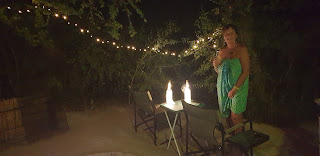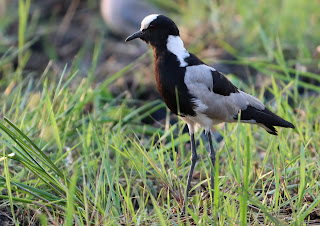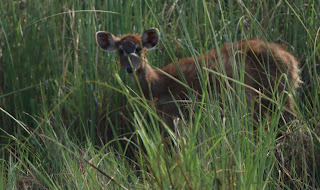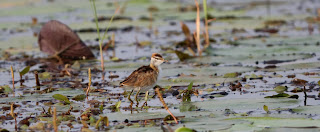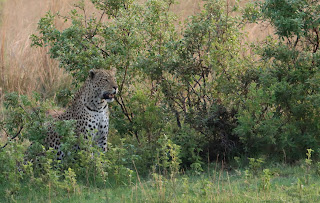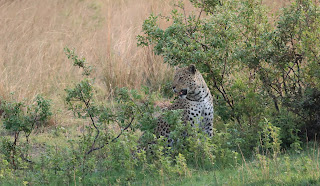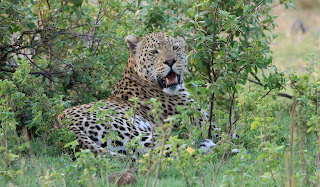We left Shamvura late morning on 8th November heading for Dan Stephen's campsite on the banks of the Kwando River. It is a 310 kms haul along the B8. Even though it is tarred, it is slow going with roadworks, slow moving traffic etc. Filled up with fuel & a bit of shopping in Divundu along the way. Arrived at Mashi Campsite late afternoon.
We had been here two years ago & really liked the place. Each campsite overlooks the floodplain & the Kwando River looking across into Bwabwata National Park. This time we were in campsite 2, with excellent, expansive views & good birding from the camp itself. This is Africa in the raw! Lions, Hippos & Hyena all close by in an unfenced camp. In this portion of the Caprivi Strip human population density is high, so the tinkling of cow bells is never too far away. Humans & wildlife live here in a kind of uneasy truce & sometimes conflicts occur. However, there is nothing quite like cooking food over an open fire, enjoying a drink & listening to Lions roaring, knowing there is no barrier between you & them. This is exactly what happened on our first night.
We decided to spend all day in camp on the 9th November. Sometimes it is nice just to stay put & relax. We did an early morning birdwatch from the camp itself which was quite rewarding:
Coppery-tailed Coucals are in the floodplain & associated reedbeds, while White-browed Coucals are in the riverine woodland at the edge of the floodplain. While Senegal Coucals are in the dry woodland patches inland. here it is possible to see all three species within around 500 m. Collared Pratincoles were over the floodplain; lots of Purple Herons around; an adult male Amur Falcon flew over, as did a Lanner later on; Meyer's Parrots; Swamp Boubou & Hartlaub's Babbler are all common in camp. Both Holub's Golden Weaver & Southern Brown throated Weavers were in the reedbeds.
Then it was time to do the laundry & other camp chores! In the evening we spent a couple of hours at the sundowner spot along the river. We saw 60 species including: Rufous bellied Heron; 55 Collared Pratincole; a good variety of Herons & Egrets including 14 Purple Herons; Chirping & Zitting Cisticolas; Banded Martin; Swamp Boubou; both Red billed & Brown Firefinches.
We also enjoyed a glorious sunset!
Up early on 10th November, sat in my camp chair with my coffee & watched the day unfold. It really was a brilliant setting. unfortunately I missed the moment! Two Spot-necked Otters swam across the river & into the reeds. Good views through the binoculars, but failed to get a shot! Gutted! This is only my second sighting of this species.
Birding was good though, with 66 species:
African Crake calling; Rufous bellied Heron; 6 Squacco Heron; 50+ Collared Pratincole; 18 Woolly-necked Stork; White-headed, White-backed & Hooded Vultures; Black-chested Snake- Eagle, Gabar Goshawk; Broad-billed Roller; Chirping Cisticola & Fan-tailed Widowbird.
In the afternoon we went on a boat trip down the Kwando River toward Horseshoe Bend in the national park. Issak proved to be both a competent boatman & an engaging & knowledgeable companion. We were the only people on the boat, it was stable & very quiet so we could sneak up to birds quite well without alarming them.
We slowly meandered our way through the channels towards Horsehoe Bend inside the national park. Luckily one can enjoy game viewing in this manner without having to pay park fees! Surely watching game & birding by boast is the best way of enjoying wildlife?
Among the abundant Red Lechwe we spotted a shy female Siatunga, which as usual, just melted away at the first glance. We also got nice & close to a small herd of ten Cape Buffalo. In the distance we saw a fine male Sable & other species included Impala; Kudu; Warthog & Baboons. As well as a couple of pods of Hippo!
We managed to see a lovely Lesser Jacana on the lily pads of the lagoon. Also present were ten very mobile African Pygmy Geese, which manage to elude the camera.
We also get close to Chirping Cisticola in the reedbeds, a species which we don't often observe. Three Long-toed Lapwings proved to be shy & distant, along with both Blacksmith & African Wattled Lapwings & 130+ Collared Pratincoles.
Hirundines were represented by 20+ Banded Martins; Hundreds of Barn Swallow, Wire-tailed Swallow & Plain-throated Martins.
On our return we spotted a beautiful male Leopard resting by the side of a bush on the riverside. We spent quite sometime with him & he was very relaxed in our presence. The highlight of the afternoon.
The next morning I was up early & looking over the marshes, river & floodplain on 11th November. Delana joined me later. Early doors saw a European Hobby hunting & later, three Lesser Kestrels. In the next three hours were recorded 75 species including: Slaty Egret; Rufous bellied Heron; 350+ European Swift; African Snipe; 50+ Collared Pratincole; Lappet-faced Vulture & Brown Firefinch. The highlight was a Red-headed Quelea sat atop of a bush in the marshes. We both obtained good scope views of this hard to see species.
We were up before dawn on 12th November to board our boat for another excursion down the Kwando River. We again set course for Horseshoe Lagoon in the national park. Our first notable sighting was a young male Sitatunga which unbelievably did not bolt straight into the swamps! It gave us great views but the light was terrible for photography. A little further along the channel we came across a female. I have been wanting to photograph this species for a long time now but it had always eluded me. So pleased with these shots.
c140 Collared Pratincoles were on the floodplain along with Long-toed Lapwing & other common wetland species.
A nice herd of Common Reedbuck were seen & the African Pygmy Geese were still present. It was a lovely morning out & we returned around 9 am for breakfast in camp. We spent the rest of the day in camp & birded around camp late afternoon/evening.
We had an early start on 13th November as we had to get our PCR test done before 1pm, so we could cross into Botswana next week. It had been a lovely stay here & we were reluctant to leave. Birding from th camp was excellent, as was the feel of wilderness all around.






















